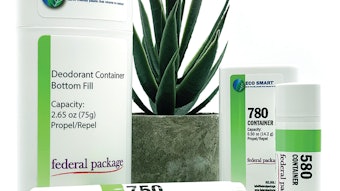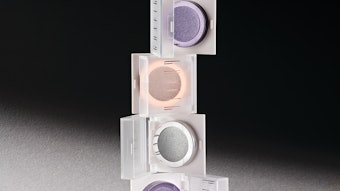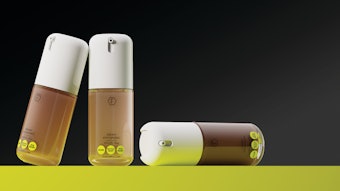More and more, beauty products must appeal to five senses—in particular, the color, texture and aroma of a product must appeal to the target consumer. It makes sense then that the packaging supports the feel and appearance of the product it holds—but can packaging do more?
With the rapid proliferation of new products in the marketplace, suppliers are helping brands look beyond the traditional packaging palette to include as many packaging sensory cues as possible in the marketing and product development. Sensory innovations can include visual benefits, tactile effects and even audio clues.
“We are living in a world of ‘smart technology’ that is becoming an everyday feature in our lives, even with beauty tools and devices that help deliver salon results at home,” says Sandra Hutson, sales and marketing director, Topline Products.
Brand consultancy Interbrand US divides sensorial packaging for beauty into two categories: conscious and unconscious. Containers for cosmetics—particularly, fragrances—make more conscious tactile appeals to the consumer. Modern perfume bottles come in all shapes and sizes of glass. Elegant, sculpted glass containers provide the consumer with a sense of luxury, for example.
Tactile encounters with toiletry packages tend to be unconscious, aside from designs made with ergonomics in mind—such as when Topline Products developed the Neotensil Reshaping Tool for the brand Living Proof. The innovative applicator has been designed to optimize the performance of the formula and has an engineered shape that provides maximum control with consistent application pressure. The real innovation of this tool is the “cool-touch” tip, which is specially designed to minimize friction and help enhance the formula’s results.
More convenient, more hygienic and often adding to the consumer’s overall product experience, direct applicators have become increasingly popular in skin care. Fusion recently launched Direct Effect Airless Applicators, a line of bottle-based, piston-driven direct applicators designed to enhance the product application experience. The line features three unique applicator styles designed with the consumer in mind.
“The first-of-its-kind curved tip applicator precisely contours to the delicate areas of the face, allowing the silky thermoplastic elastomers (TPE) surface to glide across the skin with a feather-light touch,” says Alexander Kwapis, creative director at Fusion Packaging.
The line also features single and dual stainless steel rollerballs for massaging benefits and to enhance the absorption of skin care products.
“Consumers can feel the difference a quality applicator can make, from the instantly refreshing touch of stainless steel to the cushy feel of TPE,” explains Kwapis. “And the ergonomic textured finger pad allows for easy, single-hand application.”
Supplier Innovation
Packages often use shapes that conform to being held in the hand, with many textures and finishes that make them more sensual. The development of new materials, manufacturing processes and packaging materials/components are strong drivers in the creation of products and packaging that provide sensory effects.
Fusion recently worked with dōTERRA International to develop two packages that combined a matte spray with a clear silkscreen effect, which gave the Tru bottle and Tru airless tube a really interesting dimension. When consumers hold the package in their hands, there is a unique juxtaposition between the more granular matte and ultra-smooth transparent silkscreen. “The combination results in a beautiful visual and tactile experience that makes the brand more memorable,” says Kwapis.
When designing new products, it’s important to keep in mind the consumer’s understanding of the package. “We wanted to push the boundaries with new forms and materials, but we also had to pay attention to what was already on the market and which shapes consumers sought out for specialty skin care,” says Kwapis. Fusion went through several rounds of trial and error before deciding on the final applicators in the Direct Effect line. To bring the innovations to market much faster, however, the supplier used existing components from its stock collections.
What the Future Holds
Looking toward the future, as brands think outside the traditional box and utilize sensory cues that make the decision to buy or not to buy at the retail shelf a simpler one for consumers, those brands will also be able to better capitalize on opportunities for growth—which also lead to more opportunities to incorporate emerging technologies into the packaging story. “I believe sensory packaging will be designed to work with different devices and apps that will analyze the product’s performance or the skin’s characteristics to create unique, customized solutions,” says Hutson.
Imagine a package that indicates exactly which shade of eye shadow or skin care formulation is right for a specific consumer as that consumer picks up the product from the retail shelf. Taking the guesswork and human error out of the equation means more consumers will be confident in the selection and be more likely to be satisfied with their purchase.
“Tech-savvy consumers have an insatiable appetite for new experiences—novel sensations and visual eye candy, driving sensory application in marketing,” says Hutson. “Our goal is simply to deliver package solutions that will make life easier for the consumer—easier to use, easier to select on shelf and more efficient.”
With so many products on the market often claiming to achieve the same results, packaging really allows brands to set themselves apart. “The packaging is what first catches the consumer’s eye, so creating a sensory experience [when they interact with] the product can increase curiosity and drive trial, which ultimately leads to sales,” adds Kwapis.
With such a brief window to make an impression on the consumer, sensory packaging can increase brand interaction and build a connection so that product stays at top of mind.
Sara Mason is a freelance writer based in the Chicagoland area. She was previously managing editor of GCI magazine.










